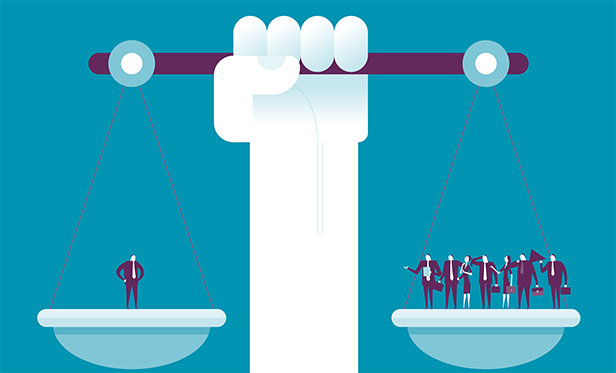
The Equal Employment Opportunity Commission (EEOC) enforces federal laws related to workplace discrimination. In many cases, the EEOC rules definitively on an employee's wrongful-termination or harassment complaint. But even when the EEOC does not file charges, the company may not necessarily be in the clear.
That's confusing for many people. The EEOC has 180 days from the date a claim is filed to investigate that claim. If the EEOC decides not to litigate, the charging party will receive a Notice of Right to Sue. This typically signals the end of the EEOC's investigation and involvement, but the business is still at risk of being sued by the charging party, who has 90 days to file a lawsuit in federal court.
While claims of discrimination, harassment, and retaliation are nothing new, the costs associated with them are soaring. According to the EEOC, the average total claim cost in 2017 was $460,000. Settlement payments averaged $160,000 while defense costs averaged $300,000.
Here are five key ways a company can protect itself from a lawsuit:
1. Pay attention to hiring practices.
Companies need to create a job description for each position that clearly defines expectations of skill and performance. They should use an employment application that contains an equal employment opportunity statement, along with a statement that if an individual is hired, his or her employment will be “at-will.” This means employment can be terminated at any time, for any reason or for no reason at all, with or without notice.
It's also important to make sure the employment application does not include any age indicators, such as asking for the year a candidate graduated from high school. Such a question could increase the company's risk of age discrimination claims.
Businesses need to develop a screening and hiring program that weeds out unsuitable candidates early in the process, before they are called to interview in person. Then, once the organization has decided on a candidate, it should conduct a background check prior to making the employment offer. Managers should make sure to follow the Federal Fair Credit Reporting Act (FCRA) national standards for employment screening.
2. Develop a comprehensive employee handbook.
Every company needs an employee handbook, and it is critical for that handbook to state that the organization has zero tolerance for violence, substance abuse, harassment, or discrimination of any kind, including bullying. The handbook should include information on how to report violent acts or suspicious behavior, and how to document and report threats.
Likewise, the handbook must define the various types of harassment and how employees can identify harassment. It should document the ways in which employees can report complaints, identify whom they can talk to in the company to address their concerns, and define the steps the company will take to investigate any claims. An open-door policy in which employees can report infractions without fear of retribution is crucial.
Additionally, the handbook should detail workplace policies and procedures that guide hiring, disciplining, and terminating employees. It should outline attendance expectations, including identifying what constitutes as misconduct, and how complaints or disciplinary actions will be handled. Finally, the handbook should Include an employment at-will statement and equal employment opportunity statement to provide additional protection.
3. Document employee performance.
Another key measure to protect the organization from lawsuits is to create an effective recordkeeping system that documents employee issues as they arise, as well as what the company did to resolve those issues. Organizations need to conduct periodic performance reviews of employees and carefully note the results in personnel files. Employee performance—both successes and failures—should be documented. Records need to include exactly what the employee did and said, as well as what the manager did and said. Any agreements, goals, expectations, and timelines discussed during the conversation should also be documented.
See also:
- To Improve Talent Management, Focus on Communication
- Understanding the Complexities of Worker Recognition
Documentation provides evidence that performance issues were discussed with the employee in a timely and concise fashion. In termination situations, it also provides the evidence that supports that decision and can prove the employee was terminated for legal reasons. The more documentation an organization has, the better its protection in any legal suits.
4. Understand employment law.
A variety of laws exist to protect the rights of employees or those seeking employment. Hiring managers throughout the organization need to take the time to understand all the employment laws that affect their business, including:
- Title VII of the Civil Rights Act of 1964: Prohibits discrimination on the basis of race, color, religion, national origin, or sex. It also prohibits sex discrimination on the basis of pregnancy, as well as sexual harassment.
- Equal Pay Act of 1963: Prohibits employers from paying different wages to men and women who perform essentially the same work under similar working conditions.
- Civil Rights Act of 1966: Prohibits discrimination based on race or ethnic origin.
- Immigration Reform and Control Act of 1986: Prohibits discrimination on the basis of national origin or citizenship of persons who are authorized to work in the United States.
- Americans with Disabilities Act of 1990: Prohibits discrimination against persons with disabilities.
- U.S. Bankruptcy Code: Prohibits discrimination against anyone who has declared bankruptcy.
- Equal Employment Opportunity Act of 1972: Prohibits discrimination against minorities based on poor credit ratings.
- Age Discrimination in Employment Act: Prohibits discrimination against individuals who are age 40 or older.
5. Consider employment practices liability insurance.
Employment practices liability insurance (EPLI) protects the company, managers, and employees against alleged wrongful acts like wrongful termination, discrimination, sexual and workplace harassment, failure to hire or promote, retaliation, and employment-related invasion of privacy.
Specifically, EPLI kicks in when a lawsuit alleging harassment, discrimination, or wrongful termination is brought against an organization, regardless of whether the company wins the suit. The insurance provides assistance with legal defense costs and reimburses the company for judgments and settlements. According to the International Risk Management Institute, EPLI can also protect against charges of defamation, invasion of privacy, failure to promote, deprivation of a career opportunity, and negligent evaluation.
Related reading:
- States Where Employee Lawsuits Are Most Likely
- Age Discrimination Issues in Hiring and Recruitment
- How to Hang onto Your Top Talent
- Convince Your Best Employees to Stay
Sandra Lowery, CIC, ([email protected]) is an account executive at CBIZ Insurance Services, Inc., in Kansas City, Mo.
From: PropertyCasualty360
© 2025 ALM Global, LLC, All Rights Reserved. Request academic re-use from www.copyright.com. All other uses, submit a request to [email protected]. For more information visit Asset & Logo Licensing.




